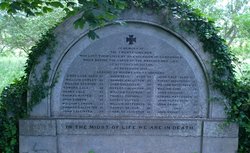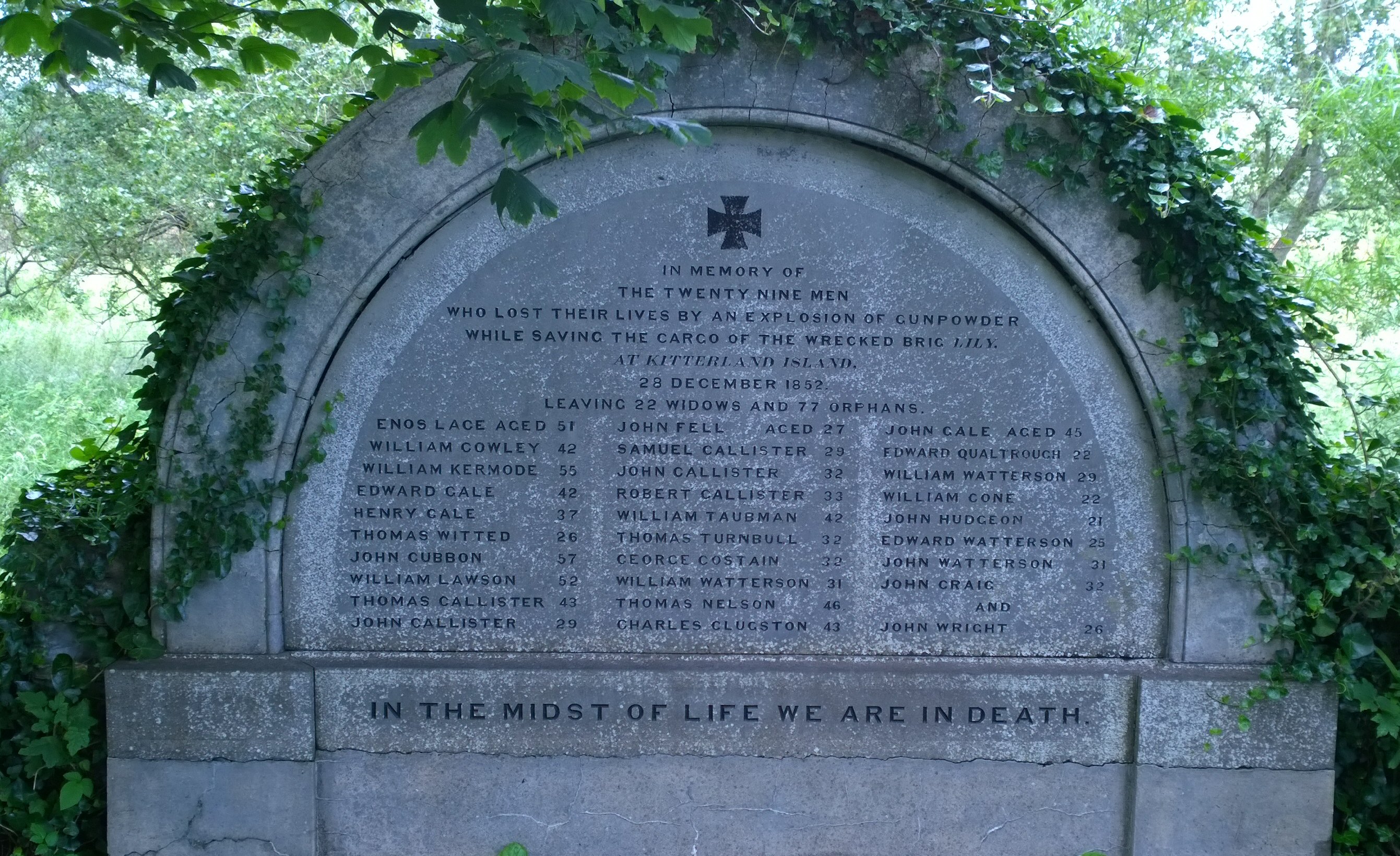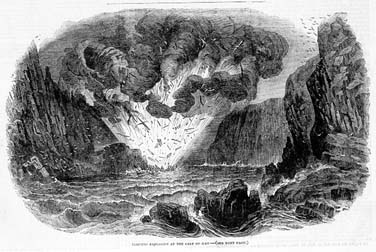While the crew were desperately trying to reach the rocks by boats, massive waves carried off the master, two lads and the cook with the ship's carpenter being killed instantly by one of the ship's masts when it fell. The remaining crew were rescued from the rocks by local men from Port St Mary
The wreck was put under police guard and by the next morning the winds had eased enough to allow a 30 man salvage team, made up of local Rushen Parish men; fisherman, carpenters, a grocer and shipwrights, to go on board in an attempt to save what cargo they could. This team was lead by Mr Enos Lace, a grocer and ship broker who was sub-agent for Lloyds
When the men boarded the brig at 6am there were reports of a smell of smoke and by 7.55am the whole of the south of the island was rocked by an all mighty explosion akin to a sizable earthquake
Carpenters had cut a hole in the deck mid-ships in an attempt to locate and extinguish the source of the smoke but the sudden inflow of air below decks immediately fanned the source of the smoke into flames igniting the 40 tons of gunpowder in cargo fore and aft of the ship
It was supposed that a candle left smouldering overnight by plunderers who had boarded the vessel unbeknownst to the police guard, was what caused the blast
Houses were shaken in Douglas, the capital of the island, some 18 miles distant with debris from the explosion found upwards of 5 miles away; a grisly mix of body parts, bits of personal belongings and fragments of the Brig herself. The devastation was complete, the entire ship including its copper sheeting, ironwork and guns were blasted into minute fragments
Miners at Ballacorkish (aka Rushen Mines) on the hillside above the village of Colby reported "their candles went out and they were thrown over" by the force of the explosion
One survivor, James Kelly, who was deafened by the blast, awoke in a pool of blood after being stripped naked by the explosion and blown onto a rock at the Sound
This disaster killed 29 men and left grieving 22 widows and 72 fatherless children in the village of Port St Mary, some were left in a most destitute condition and wholly dependent upon the charity of the community. A local gentleman began a fund for them by contributing £100 expecting the merchants of Liverpool and the Lloyd's underwriters to likewise lend their assistance
In addition to the monument in this church yard, there is also a monument to this tragedy at the Sound, unveiled in 1994
While the crew were desperately trying to reach the rocks by boats, massive waves carried off the master, two lads and the cook with the ship's carpenter being killed instantly by one of the ship's masts when it fell. The remaining crew were rescued from the rocks by local men from Port St Mary
The wreck was put under police guard and by the next morning the winds had eased enough to allow a 30 man salvage team, made up of local Rushen Parish men; fisherman, carpenters, a grocer and shipwrights, to go on board in an attempt to save what cargo they could. This team was lead by Mr Enos Lace, a grocer and ship broker who was sub-agent for Lloyds
When the men boarded the brig at 6am there were reports of a smell of smoke and by 7.55am the whole of the south of the island was rocked by an all mighty explosion akin to a sizable earthquake
Carpenters had cut a hole in the deck mid-ships in an attempt to locate and extinguish the source of the smoke but the sudden inflow of air below decks immediately fanned the source of the smoke into flames igniting the 40 tons of gunpowder in cargo fore and aft of the ship
It was supposed that a candle left smouldering overnight by plunderers who had boarded the vessel unbeknownst to the police guard, was what caused the blast
Houses were shaken in Douglas, the capital of the island, some 18 miles distant with debris from the explosion found upwards of 5 miles away; a grisly mix of body parts, bits of personal belongings and fragments of the Brig herself. The devastation was complete, the entire ship including its copper sheeting, ironwork and guns were blasted into minute fragments
Miners at Ballacorkish (aka Rushen Mines) on the hillside above the village of Colby reported "their candles went out and they were thrown over" by the force of the explosion
One survivor, James Kelly, who was deafened by the blast, awoke in a pool of blood after being stripped naked by the explosion and blown onto a rock at the Sound
This disaster killed 29 men and left grieving 22 widows and 72 fatherless children in the village of Port St Mary, some were left in a most destitute condition and wholly dependent upon the charity of the community. A local gentleman began a fund for them by contributing £100 expecting the merchants of Liverpool and the Lloyd's underwriters to likewise lend their assistance
In addition to the monument in this church yard, there is also a monument to this tragedy at the Sound, unveiled in 1994
Inscription
In Memory of the Twenty Nine Men
Who lost their lives by explosion of Gunpowder
while saving the cargo of the wrecked Brig Lily
at Kitterland Island
28 December 1852
Leaving 22 widows and 77 orphans
Enos Lage Aged 51
William Cowley 42
William Kermode 55
Edward Gale 42
Henry Gale 37
Thomas Witted 26
John Cubbon 57
William Lawson 52
Thomas Callister 43
John Callister 29
John Fell 27
Samuel Callister 29
John Callister 22
Robert Callister 33
William Taubman 42
Thomas Turnbull 32
George Costain 32
William Watterson 31
Thomas Nelson 46
Charles Clugston 43
John Gale 45
Edward Qualtrough 22
William Watterson 29
William Cone 22
John Hudgeon 21
Edward Watterson 25
John Watterson 31
John Craig 32
and
John Wright 26
"In the midst of life we are in death."
Advertisement
Advertisement



